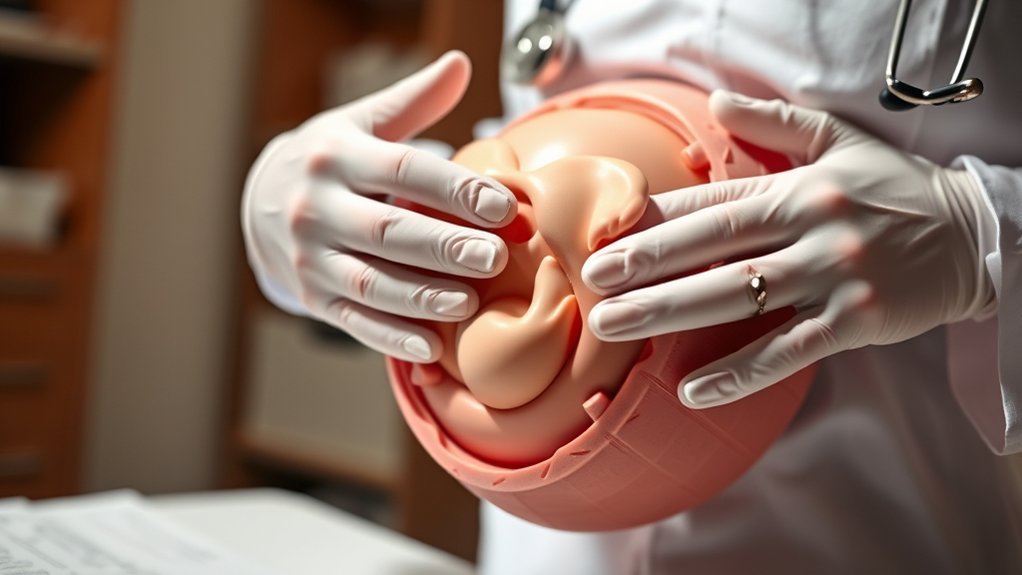If you’re considering a membrane sweep to help induce labor, it’s essential to understand the procedure and its implications. Knowing the signs that warrant a call to your healthcare provider can guarantee your safety and that of your baby. From unusual symptoms to common concerns, being informed is key. So, what should you be on the lookout for after the procedure?
Understanding Membrane Sweep: What It Is

A membrane sweep is a common procedure used to help initiate labor in pregnant women who are near or past their due date. This technique involves your healthcare provider inserting a gloved finger into your cervix to separate the amniotic sac from the uterine wall.
By doing this, they aim to release hormones called prostaglandins that may encourage contractions. While it’s generally considered safe, you might experience some discomfort or spotting afterward.
It’s important to have a discussion with your doctor about potential risks and benefits. If you’re considering a membrane sweep, make sure you’re informed about your options and ask any questions you may have to make the best choice for your situation.
How a Membrane Sweep Works

When your healthcare provider performs a membrane sweep, they gently insert a gloved finger into your cervix to create separation between the amniotic sac and the uterine wall.
This action stimulates the release of hormones, specifically prostaglandins, which can help initiate labor. The procedure usually takes just a few minutes and may cause some discomfort or cramping, but it’s generally considered safe.
Your provider will monitor your critical signs and your baby’s heart rate during and after the procedure. It’s important to discuss any concerns you have beforehand, as well as the timing of the sweep, to guarantee it aligns with your birth plan.
Always follow up with your healthcare provider for any unusual symptoms post-procedure.
Potential Benefits of a Membrane Sweep

A membrane sweep can offer several potential benefits for expectant mothers.
It may help induce labor naturally, which can reduce your overall pregnancy duration and lessen the need for medical interventions.
Understanding these advantages can empower you to make informed decisions about your childbirth experience.
Inducing Labor Naturally
While many expectant mothers seek ways to induce labor naturally, a membrane sweep can offer a viable option. This procedure involves a healthcare provider inserting a finger into the cervix to separate the amniotic sac from the uterine wall.
By doing this, it may release hormones that help stimulate contractions. Many women find that a membrane sweep can be effective in encouraging labor to begin, especially if they’re overdue.
It’s a relatively quick procedure, often done during a routine check-up, and can be less invasive than other induction methods. However, it’s essential to discuss this option with your healthcare provider to guarantee it aligns with your individual health circumstances and preferences.
Always prioritize safety and informed choices when considering labor induction methods.
Reducing Pregnancy Duration
Membrane sweeps can play a significant role in reducing pregnancy duration for those who are past their due date or experiencing complications. This procedure involves a healthcare provider sweeping a finger around the cervix to separate the membranes from the uterus.
By doing this, it releases hormones called prostaglandins, which can help stimulate contractions. Many women find that a membrane sweep can lead to labor starting naturally within days.
It’s generally considered a safe option when performed by a qualified professional, and it can potentially avoid the need for more intensive medical interventions.
If you’re nearing your due date or have concerns, discussing a membrane sweep with your doctor can help you weigh its benefits and risks.
Minimizing Medical Interventions
Considering the potential to minimize medical interventions, a membrane sweep can be an effective option for women approaching labor. This procedure can help stimulate natural contractions, reducing the likelihood of needing medications like Pitocin or even a cesarean section.
Here’s a quick comparison of the benefits:
| Benefits of Membrane Sweep | Alternatives |
|---|---|
| Reduces need for induction | Medical induction drugs |
| Encourages natural labor onset | Cesarean delivery |
| Less invasive than other options | Prolonged hospital stay |
Risks and Considerations
When considering a membrane sweep, it’s essential to understand the potential complications involved, including bleeding or infection.
Timing plays a vital role in determining the effectiveness and safety of the procedure.
Be aware of any signs of infection, such as fever or unusual discharge, and don’t hesitate to reach out to your doctor if you notice anything concerning.
Potential Complications Involved
Although a membrane sweep is generally considered a safe procedure, it does come with potential complications that you should be aware of.
Some women experience discomfort or cramping during and after the procedure, which can be normal but may also indicate a more serious issue.
There’s a risk of premature rupture of membranes, leading to possible infection or complications for the baby.
Additionally, some may experience bleeding, which can be alarming but isn’t always a cause for concern.
However, if the bleeding is heavy or accompanied by severe pain, you should contact your healthcare provider immediately.
Understanding these risks can help you make an informed decision about whether to proceed with a membrane sweep.
Timing Considerations
Timing is essential for a membrane sweep, as its effectiveness and safety can vary depending on your gestational age and individual circumstances.
Generally, healthcare providers recommend scheduling the procedure after you reach at least 39 weeks of pregnancy. Performing a membrane sweep too early may not yield desired results and could lead to unnecessary complications.
You should also consider your overall health and any pre-existing conditions that might affect the procedure’s outcomes. If you’ve experienced any concerning symptoms, such as irregular contractions or unusual discomfort, it’s vital to consult your doctor before proceeding.
Always discuss your specific timing concerns with your healthcare provider to guarantee that a membrane sweep aligns with your unique situation and promotes a safe delivery.
Signs of Infection
After considering the timing of a membrane sweep, it’s important to be aware of the signs of infection that could arise from the procedure. Recognizing these symptoms early can help you seek prompt medical attention.
| Symptom | Description | Action Required |
|---|---|---|
| Fever | Elevated body temperature | Contact your doctor |
| Unusual Discharge | Foul-smelling or colored discharge | Seek medical advice |
| Increased Pain | Severe abdominal or pelvic pain | Call your healthcare provider |
| Swelling | Swelling in the vaginal area | Consult your doctor |
| Chills | Feeling cold or shivering | Report to a healthcare provider |
If you notice any of these signs, don’t hesitate to reach out to your healthcare professional for guidance. Your health and safety are paramount.
Signs That Indicate You Might Need a Membrane Sweep
As your due date approaches, you may notice certain signs that suggest it’s time to contemplate a membrane sweep. If you experience a decrease in fetal movement, it could indicate the need for intervention.
Additionally, if you’re past your due date, your healthcare provider might recommend a membrane sweep to encourage labor. Persistent Braxton Hicks contractions or irregular contractions can also signal that your body is preparing for labor, making a sweep beneficial.
If your cervix shows signs of dilation or effacement during your check-ups, discussing a membrane sweep can be worthwhile.
Finally, if you’re feeling anxious about your baby’s readiness for birth, bringing up a membrane sweep with your provider can help ease your concerns.
When to Contact Your Healthcare Provider
When you notice any concerning symptoms or changes in your condition, it’s vital to reach out to your healthcare provider. If you experience heavy bleeding, severe abdominal pain, or a significant decrease in fetal movement, don’t hesitate to call.
Additionally, if you develop a fever, notice unusual discharge, or have persistent contractions that don’t subside, it’s important to seek medical advice immediately. Your provider can help determine if these symptoms indicate a need for further evaluation or intervention.
What to Expect During the Procedure
During a membrane sweep, you can expect a straightforward procedure that your healthcare provider performs to help initiate labor. You’ll likely feel some discomfort, but it shouldn’t be overly painful.
Here’s what typically happens during the procedure:
- Your provider will examine your cervix to determine its readiness.
- They’ll use a gloved finger to sweep around the membranes of the amniotic sac.
- You may experience cramping or spotting afterward.
- The whole process usually takes only a few minutes.
- Your provider will discuss any signs of labor or complications to watch for afterward.
It’s vital to ask questions and express any concerns you may have before the procedure to guarantee you’re comfortable and informed.
Frequently Asked Questions
Can a Membrane Sweep Induce Labor in All Pregnancies?
A membrane sweep can induce labor, but it doesn’t work for everyone. Its effectiveness varies based on individual circumstances, including gestational age and cervical readiness, so results may differ from one pregnancy to another.
How Soon After a Membrane Sweep Should I Expect Labor?
You might feel like labor’s just around the corner after a membrane sweep, but it typically occurs within 48 hours. Every body’s different, so don’t panic if it takes a little longer.
Is a Membrane Sweep Painful?
A membrane sweep can be uncomfortable or mildly painful for some, but experiences vary. You might feel cramping or pressure during the procedure, but it’s generally quick, and any discomfort usually subsides shortly after.
Can I Have a Membrane Sweep if I’Ve Had a Previous Cesarean?
Yes, you can have a membrane sweep after a previous cesarean, but it’s essential to discuss this with your healthcare provider. They’ll evaluate your specific situation and make certain it’s safe for you and your baby.
Are There Any Alternatives to a Membrane Sweep?
Yes, there are alternatives to a membrane sweep. You can consider methods like natural induction techniques, acupuncture, or specific exercises. Always discuss these options with your healthcare provider to guarantee they’re safe and suitable for you.
Conclusion
In conclusion, understanding the membrane sweep, knowing its benefits and risks, and recognizing the signs that warrant a procedure can empower you during this vital time. If you experience heavy bleeding, severe pain, or other concerning symptoms, don’t hesitate to reach out to your healthcare provider. Staying informed, staying vigilant, and staying proactive about your health will help guarantee a safer experience for both you and your baby as you approach labor.
